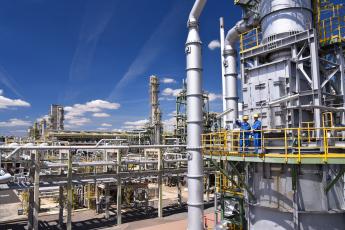Employee health and safety is top priority for the fuel and petrochemical industries, and the COVID outbreak has necessitated a number of changes to business operations. We sat down with AFPM Vice President of Technical and Safety Programs Lara Swett and Senior Manager of Safety Programs Daniel Forest to discuss how the industry is evolving its safety practices in the wake of the pandemic.
How have fuel and petrochemical companies adjusted their business operations to keep their employees healthy and safe during the COVID-19 pandemic?
Daniel Forest: Our companies have preparedness plans in place that cover all kinds of scenarios. If it’s a weather event like a hurricane or another potential disruption like the health situation we’re currently facing with coronavirus, fuel and petrochemical manufacturers have plans and processes at the ready that they can use to adapt to any situation as it evolves.
In this case, the bulk of the effort was geared towards changing shift times structure and reducing staff in facilities to enable proper social distancing. Part of that includes limiting on-site staff to essential personnel, both at the facilities and within corporate offices. If employees can work from home, they are. Facilities are also switching around their shifts to keep employees separated and to limit overlap.
And facilities are taking additional precautions such as using additional personal protective equipment (PPE) and face masks. Much like at grocery stores, they’ve put tape on the ground and in elevators as a reminder to help keep individuals at a distance anytime people need to be in close proximity of each other, such as when they’re getting into the gate going into work.
Across the country sites have deployed fever detection technology like infrared cameras that take people’s temperatures. And some facilities are installing foot pedals on bathroom and high-traffic doors, to reduce common touch points.
Our member companies have made communication and transparency a priority. They are having conversations to make sure all employees are aware of potential harms and making sure they know that if they don’t feel well, they shouldn’t come in to work.
Lara Swett: The underlying theme that has helped the industry make these changes, keep people safe and make sure that the people coming on the site are responsible is the culture of safety throughout all these plants. Their priority is to keep their families, themselves, and their coworkers safe. So they’ve taken a lot of precautions in their personal lives to make sure there wasn’t any spread of virus. The overall goal is to maintain social distance, protect operators so they can continue working and have redundancies in case of exposure.
DF: One thing that’s been evident over the past couple months is that safety and hygiene are so ingrained in our industry’s culture that employees easily adapted to extending that mentality beyond work to such things as wearing a mask at grocery store. The industry safety processes have been developed over years and they’ve really allowed us to come through this well.
LS: This is a workforce with a strong safety culture; whether they’re at home, outside with friends, or at a facility, it’s about prioritizing the health and safety of your coworkers, your families and your facility.
What differences will employees see when they return?
LS: They’ll definitely see face masks, they’ll see helpful signage to enforce the six-foot distancing, and they will probably see some plexiglass where employees have to work in close proximity like between operator consoles. A lot of that already exists. A big difference is that the people right now in administrative buildings have been working at home.
DF: In the short term, for many companies, if you can work from home then you are. When we’re a little bit further along, you’ll see every other seat or every third seat in a conference room being used.
I see a lot of people starting to use video chat and, longer term, that’ll probably be continued. If the work can be done without having to travel or go into a facility and have that in-person interaction, you’ll probably see that switch to video for a variety of reasons. (chat meetings, video audits, or video inspections. It will be a business decision, but there will be longer-lasting effects for video more so than the plexiglass or face masks or distancing in conference room, we’re seeing now.
LS: On technology: what we’ve seen is that companies have really embraced the tech onsite — for example, utilizing Facetime for operator rounds or interaction with Maintenance staff. Some companies were already experimenting with video chat for remote experts, however during the pandemic it has become more wide spread. We predict that we will see more of this interaction in the future as it has been proven to work.
What preparations are being made for potential future upticks in COVID-19 cases?
LS: The industry is really good at putting plans in place if there’s the potential for a need to use them. So while I haven’t heard specifically about plans for a second wave, what is most likely to happen is that companies will evaluate all of the learnings from what they’ve done since February (internationally as well, since a lot of companies have global operations), identify ways to improve, then in preparation for a potential second wave, identify those triggers as to when they need to start phasing in some of their additional work-from-home plans or whatnot.
In terms of phasing in more people coming on to the facility, they’ll be really proactive in making sure they’re keeping those people safe, and then really be able to react to changes as needed.
DF: A couple of things that I’ve seen throughout this process. First of all, you have a corporate office that writes guidance or directives to all of its sites. Those sites might take that guidance and adapt it a little more to make it site-specific. For example, you might want to open up additional plant entry ways and alternate which groups can go through which entryways to maintain social distancing. And the site might elaborate more to fill in details according to their individual parameters. All sites are different and have unique considerations that are important to take into account.
The company guidance that will bring people back to work will be very similar take into account a lot of different variables. Will they take into account what the federal government says? Of course they will. They will take into account all considerations and make the best choice for the safety of their employees, their families, and their communities.
LS: And companies are doing that right now in terms of Phase 1 triggers. States are pursuing different policies and re-opening schedules, so companies are conducting different evaluations in different states and even in different counties.
We’ve seen some large companies sharing their return-to-work plans publicly. What’s the thinking behind that?
LS: One of the reasons is that larger, global companies have already been dealing with this issue in other countries. They share their planning and processes publicly so that the smaller companies that might not have international experience can take this information, learn from it, and adapt it to suit their own operations.
Our industry, especially when it comes to safety and protecting employees, has really been historically good at knowledge sharing. This kind of knowledge sharing — really making sure that everyone knows as much as possible and is able to ask questions and learn from experiences — is a long-standing tradition in our industry, even before it was formalized into knowledge-sharing groups. These companies really prioritize safety because they recognize their responsibility to protect their employees, contractors and neighbors.
Any closing thoughts?
DF: The entire industry has done a phenomenal job of responding appropriately to keep their employees safe. And when comparing industries down the line, I think you’ll find that the fuel and petrochemical industries did a really great job of mitigating the spread of this virus


